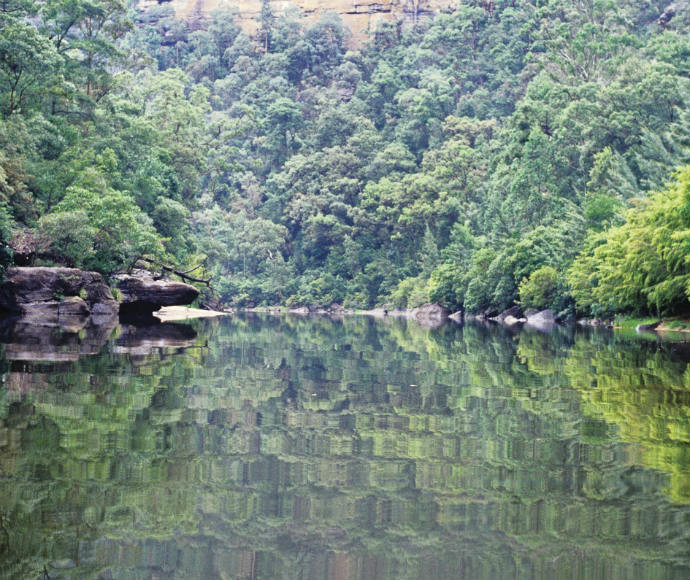All rivers within our national park system help protect plants and animals that depend on freshwater and river bank (riparian) habitats.
A wild river may be a river, a freshwater creek, an estuary or a chain of ponds that is in near-pristine condition in terms of animal and plant life and water flow. Wild rivers are free of unnatural rates of siltation or bank erosion that affect many of Australia’s waterways.
They are of high conservation value and play a potential role in maintaining other parts of water catchment areas. For example, a wild river may:
- benefit river restoration works downstream by providing sources for recolonising plants and animals
- protect biodiversity and provide a source for rehabilitation work outside parks and reserves
- help improve water quality
- assure water supply
- mitigate floods
- protect cultural and historic heritage
- ensure Aboriginal objects and places associated with them are identified, conserved and protected
- be used as a benchmark for environmental monitoring and research about water quality because of their relatively unspoilt biology, geomorphology and hydrology.
Protecting neighbouring parts of the catchment area, particularly upstream of a wild river, may increase the resilience of the river to disturbances.

The Colo River is a highlight of Wollemi National Park.
Declared wild rivers in New South Wales
Wild rivers in New South Wales are declared within national parks and other reserves, and are protected under the National Parks and Wildlife Act 1974 (NPW Act).
The rivers and their catchment areas are assessed and need to be in a relatively natural condition to be declared ‘wild’.
When a river is declared to be wild a management framework to conserve natural resources, such as streams, riparian areas and reserves, is developed. This helps us to manage these freshwater ecosystems and safeguard fresh water conservation at the highly natural end of the spectrum.
The Brogo River is in the Bega catchment in south-east New South Wales. The upper reaches of the catchment near the river’s source contain important examples of relatively unmodified landscape and freshwater plants and animals. The Brogo River’s subcatchment is immediately upstream of the Brogo Dam and provides water for the Bega district’s town and irrigators.
Read the Brogo Wild River Assessment Report.
The Forbes and Upper Hastings Rivers are in the Hastings catchment on the mid-north coast of New South Wales. These rivers form part of the Gondwana Rainforests of Australia World Heritage Area.
Read the Forbes and Upper Hastings Wild River Assessment Report.
The Kowmung River is in the Hawkesbury–Nepean catchment area. This river contributes to the water supply for Sydney. Most of the river and catchment is protected and exists within the Kanangra–Boyd National Park.
Washpool Creek is in the Washpool Creek subcatchment within Washpool National Park. This subcatchment is important to Aboriginal people because it contains significant Aboriginal sites and is used for cultural heritage education. The entire subcatchment is now declared wilderness and forms part of the Gondwana Rainforests of Australia World Heritage Area.
The Colo River is in the Hawkesbury–Nepean catchment area and covers 4 subcatchments: Colo, Wolgan, Capertee and Wollemi, which fall largely within the Wollemi and Blue Mountains National Parks. These subcatchments are important to Aboriginal people and contain significant Aboriginal sites.
Read the Colo River Wild River Assessment Report.
The Grose River is in the Hawkesbury–Nepean catchment. The rugged nature of the Grose Valley and early preservation of its natural and recreational values have limited disturbances to this area. Grazing and logging took place within the catchment in the past, and there was a mine at the source of the Grose River, but no major impacts remain.
Read the Grose River Wild River Assessment Report.
Rivers assessed as unsuitable for declaration as wild rivers
The Macdonald River is a tributary of the Hawkesbury River and is located north of the Hawkesbury and Colo Rivers and south of the Hunter Valley. A large portion of the Macdonald catchment is within Yengo National Park.
The Macdonald River was assessed for wilderness values and did not meet the criteria for declaration as a wild river under the NPW Act. The river was in poor condition due to:
- extensive sedimentation – human activities, land clearing and high intensity fires in particular, may be the causes of sand slugs (large sediment deposits) in the river
- loss of diversity, probably due to a lack of habitat diversity caused by sedimentation.
The Maria River, located near Kempsey on the New South Wales north coast, has headwaters in Kumbatine National Park and joins the Hastings River 54 kilometres downstream. The catchment of the river is made up of about 42,536 hectares, about 17% of which is in our parks and reserves and about 17% in state forests.
A detailed assessment was made of the upper third of the Maria River, its tributaries within Kumbatine and Maria National Parks, and its subcatchment. The upper Maria River met many of the criteria for a wild river but was not recommended for declaration because this part of the river occurs on a number of different tenures – only those sections of the river within our parks and reserves can be declared wild under the NPW Act. Declaration of the upper Maria River could be reconsidered if additional sections are reserved or subject to future conservation agreements.
Read the Maria River Wild River Assessment Report.